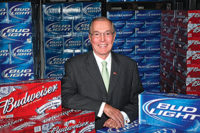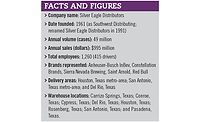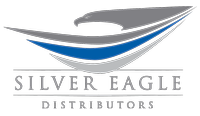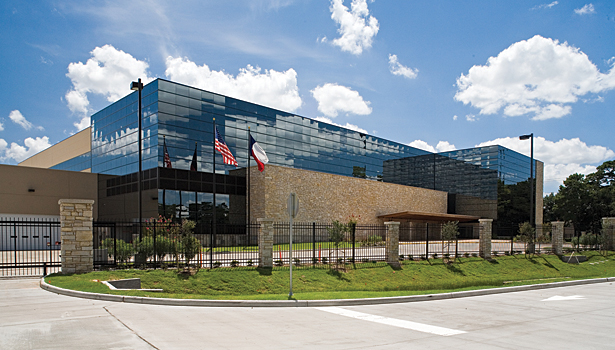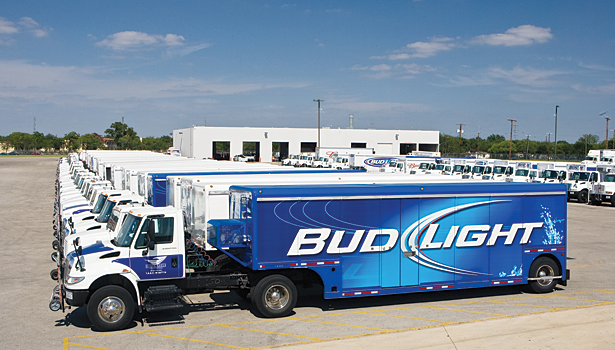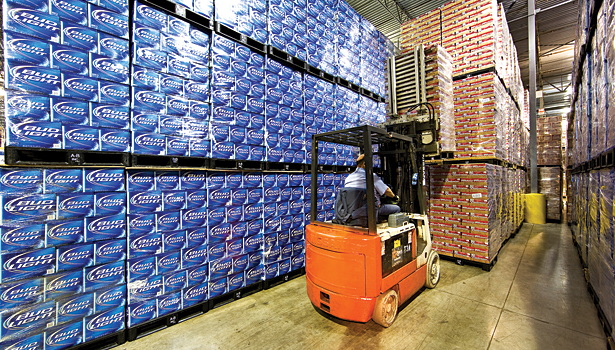Silver Eagle expands, makes sustainable upgrades

Silver Eagle’s Houston headquarters is 144,000 square feet with the capacity to hold 1.5 million cases.


The company’s San Antonio warehouse is a controlled environment with the capacity to house more than 1 million cases.



Running more than 200 routes a week to serve more than 46 million cases a year to 11,000 accounts in 16 counties in southern Texas, Silver Eagle Distributors realizes the importance of investing in its operations. The company currently has five major warehouses located in Houston, San Antonio, Cypress, Rosenberg and Conroe. The Houston warehouse is a 144,000-square-foot, controlled-environment facility with the capacity to house 1.5 million cases. The San Antonio facility, acquired from BudCo Ltd., is a 132,900-square-foot, controlled-environment facility with the capacity to hold more than 1 million cases.
Silver Eagle also runs two depots in Carrizo Springs and Del Rio, which was renovated last year. The company invested $2.3 million in a nine-month project to renovate 19,500 square feet of the existing Del Rio facility and added 10,600 square feet. Key areas of the updated facility include the creation of a controlled-environment warehouse and keg vault, which allow additional storage capacity for both packaged and draft beer; a new open-concept sales area that will enhance efficiency and work flow among Silver Eagle’s sales team; and a newly designed hospitality room to host local on-site corporate and community events. Additional updates include a new fleet maintenance area and a workout facility for Silver Eagle employees.
When the company acquired BudCo in 2007, it added approximately 35 percent to its overall volume mix, Chief Executive Officer John L. Nau III says.
“One day we’ve added one warehouse in San Antonio, two depots — one in Del Rio and the other in Carrizo Springs — and we added 13 counties, so we had to go from the metropolitan area of San Antonio to some very, very sparsely populated rural counties,” Nau explains. “It was a bit of a challenge to address the cultures of the two companies, but over time, we were able to have the culture of Silver Eagle begin to take hold within the organization.”
When the company acquired import and craft beer brands from Glazer’s Family of Companies, Dallas, less than two years later, its SKUs quadrupled, creating the need for a sixth major warehouse. In about 17 months, Silver Eagle expects to open the new facility in Houston, Nau says.
Adjusting to new SKUs
In addition to opening another facility to house its newly acquired products, Silver Eagle had to take another look at its operations. The company adjusted its sales force and the number of outlets that they serve in order to adequately represent those brands, Nau explains. The sales team also was equipped with handheld technology to help with placing orders and presenting to customers.
“What’s also important is that the handheld is not just an order tool,” Nau says. “It has a sales record and in some cases, we can use that as a presentation tool where the salesman can talk to the retailer and show him his sales history and show him a formal presentation on a new product, a new package [or] a new reset design.”
Although the company has made some alterations to accommodate the influx of new brands, its acquisitions during the last few years represent an important step forward.
“Both from a consumer portfolio and importantly from a margin mix [standpoint], this move has been highly successful,” Nau says. “And in the long term, it will only help the volume growth, the margin growth and the expertise of our sales force.”
To continue its success, the company keeps a strong focus on service.
“I define my job as making certain that every employee knows what’s expected every day,” Nau says. “[Secondly, I] provide them all of the tools, whether it’s safe, modern trucks, vans and cars; the latest technology; [or] the latest handheld equipment. Once they know what’s expected, once I give them the best equipment available, then it’s my job to get out of their way and let them do it and focus on service to the retailer, because at the end of the day, that retailer is the gateway to the consumer, and we can never lose sight of that.”
In order to make ordering as convenient as possible for its retailers, Silver Eagle’s sales force uses multiple techniques. Sales personnel, who specialize in particular outlets, either visit retailers in person, over the phone or via the conventional pedal system, Nau explains. Salespeople in the field travel to major supermarkets, mass merchandisers, convenience stores and some high-volume on-premise outlets and transmit orders from time to time throughout the day. At the same time, a group of telephone sales personnel reaches out to smaller outlets and enters those orders.
“We try to coordinate for maximum route efficiency and ensure that both the telephone sales and the presold sales are in a tight geography,” Nau says.
“[With] all of those sources of ordering, my philosophy is I want to sell a retailer the way he wants to be sold,” he continues. “Some want to be sold by phone, some want to be sold in person, and some want to have it the old-fashioned way with a pedal system.”
Once all of the orders are submitted, they are bundled and routed using geographical routing equipment similar to the types that UPS and FedEx use, Nau explains. Then, they are put into a route load sheet form that is sent to the warehouse, which begins to compile bulk loads separately from a combination of package and draft trucks. The company also has a group of routes that are exclusively draft, Nau says.
“All of that has to happen, and all the trucks have got to be loaded by 6 o’clock the next morning, and that same process happens in all five of our major warehouses,” he says.
Trucking innovation
Silver Eagle demonstrates a commitment to responsibility via numerous campaigns and charitable donations. It also puts a strong focus on supporting its local communities. Similarly, the company is committed to a sustainable fleet. Silver Eagle was the first distributor in Texas to convert its privately owned fleet to clean diesel technology.
This clean diesel burns 90 to 95 percent cleaner than traditional diesel, Nau says. Silver Eagle’s fleet manager brought the technology to Nau’s attention nearly 10 years ago, and within 36 months, the company converted all of its diesel tractors to clean diesel, he adds.
Furthermore, if the engines are retrofitted with a catalytic system, the vehicles can achieve an even cleaner burn, he says. For all of the trucks that could be retrofitted, the company implemented selective catalytic reduction technology. It also shifted some of its vehicles to using compressed natural gas. With a fleet of more than 1,200 vehicles, its utilization of ultra low sulfur diesel, clean diesel technology, compressed natural gas and vehicle retrofitting using selective catalytic reduction technology has resulted in an estimated savings of 36 tons of nitrogen oxide emissions from the air each year, the company says.
“We have some vehicles that are [using compressed natural gas] right now,” Nau says. “We’re learning, and I would say that there will be a pretty major shift to that over the next three years.” BI
Looking for a reprint of this article?
From high-res PDFs to custom plaques, order your copy today!




